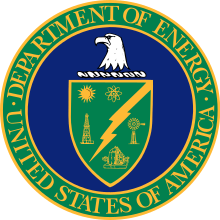United States federal executive departments
The United States federal executive departments are among the oldest primary units of the executive branch of the federal government of the United States—the Departments of State, War, and the Treasury all having been established within a few weeks of each other in 1789.
Federal executive departments are analogous to ministries common in parliamentary or semi-presidential systems but, with the United States being a presidential system, their heads otherwise equivalent to ministers, do not form a government (in a parliamentary sense) nor are they led by a head of government separate from the head of state. The heads of the federal executive departments, known as secretaries of their respective department, form the traditional Cabinet of the United States, an executive organ that serves at the disposal of the president and normally acts as an advisory body to the presidency.
Since 1792, by statutory specification, the cabinet constituted a line of succession to the presidency, after the Speaker of the House and the president pro tempore of the Senate, in the event of a vacancy in both the presidency and the vice presidency. The Constitution refers to these officials when it authorizes the President, in Article II, section 2, to "require the Opinion, in writing, of the principal Officer in each of the executive Departments, upon any Subject relating to the Duties of their respective Offices." In brief, they and their organizations are the administrative arms of the President.
Executive Departments of the present
All departments are listed by their present-day name and only departments with past or present cabinet-level status are listed.
The order of succession includes:
- the Vice President as the first in line;
- the Speaker of the House; and
- the President pro tempore of the Senate.
| Department |
Creation |
Order of succession |
Notes | 2009 Outlays in billions of dollars |
Employees |
|---|---|---|---|---|---|
| State | 1789[1] | 4 | Initially named "Department of Foreign Affairs" | 16.39 | 18,900 |
| Treasury | 1789[2] | 5 | 19.56 | 115,897 | |
| Justice | 1870[3] | 7 | Attorney General created in 1789, but had no department until 1870 | 46.20 | 113,543 |
| Interior | 1849[4] | 8 | 90.00 | 71,436 | |
| Agriculture | 1862[5] | 9 | 134.12 | 109,832 | |
| Commerce | 1903[6] | 10 | Originally named Commerce and Labor; Labor later separated | 15.77 | 43,880[7] |
| Labor | 1913[8] | 11 | 137.97 | 17,347 | |
| Defense | 1947[9] | 6 | Created by the National Security Act of 1947. Initially named "National Military Establishment" 1947-49. Created from a merger of the Department of War and Department of the Navy. | 651.16 | 3,000,000 |
| Health and Human Services | 1953[8] | 12 | Originally the Department of Health, Education, and Welfare; Education later separated | 879.20 | 67,000 |
| Housing and Urban Development | 1965[10] | 13 | 40.53 | 10,600 | |
| Transportation | 1966[11] | 14 | 73.20 | 58,622 | |
| Energy | 1977[12] | 15 | 24.10 | 109,094 | |
| Education | 1980[13] | 16 | 45.40 | 4,487 | |
| Veterans Affairs | 1989[14] | 17 | Formerly an independent agency as the Veterans Administration | 97.70 | 235,000 |
| Homeland Security | 2002[15] | 18 | Created by the Homeland Security Act of 2002 | 40.00 | 240,000 |
| Total outlays, employees: | 2,311.30B | 4,214,652 | |||
Seals
 Seal of the Department of Agriculture
Seal of the Department of Agriculture Seal of the Department of Commerce
Seal of the Department of Commerce Seal of the Department of Defense
Seal of the Department of Defense Seal of the Department of Education
Seal of the Department of Education Seal of the Department of Energy
Seal of the Department of Energy Seal of the Department of Health and Human Services
Seal of the Department of Health and Human Services Seal of the Department of Homeland Security
Seal of the Department of Homeland Security Seal of the Department of Housing and Urban Development
Seal of the Department of Housing and Urban Development Seal of the Department of the Interior
Seal of the Department of the Interior Seal of the Department of Justice
Seal of the Department of Justice Seal of the Department of Labor
Seal of the Department of Labor Seal of the Department of State
Seal of the Department of State Seal of the Department of Transportation
Seal of the Department of Transportation Seal of the Department of the Treasury
Seal of the Department of the Treasury Seal of the Department of Veterans Affairs
Seal of the Department of Veterans Affairs
Executive Departments of the past
| Department | Dates of Operation | Notes |
|---|---|---|
| Department of War | 1789–1947 | Split into Department of the Army and Department of the Air Force in the National Security Act of 1947 |
| Post Office Department | 1792–1971 | Reorganized as quasi-independent agency, United States Postal Service |
| Department of Commerce and Labor | 1903–1913 | Divided between Department of Commerce and Department of Labor |
| Department of the Army | 1947–1949 | From 1947-1949, these departments were executive departments with non-cabinet level secretaries who reported to the civilian Secretary of Defense with cabinet rank but no department. From 1949 on, they were Military Departments within the Department of Defense[16] |
| Department of the Navy | 1798–1949 | |
| Department of the Air Force | 1947–1949 | |
| Department of Health, Education, and Welfare | 1953–1979 | Divided between Department of Health and Human Services and Department of Education |
See also
References
Citations
- ↑ "Office of the Historian - Milestones - 1776-1783 - Articles of Confederation". History.state.gov. Retrieved 2012-12-29.
- ↑ "History". Treasury.gov. 2012-10-22. Retrieved 2012-12-29.
- ↑ "USDOJ: About DOJ". Justice.gov. 2009-09-30. Retrieved 2012-12-29.
- ↑ "History of Interior". Doi.gov. Retrieved 2012-12-29.
- ↑ http://www.usda.gov/documents/timeline.pdf
- ↑ "Secretaries | Department of Commerce". Commerce.gov. Retrieved 2012-12-29.
- ↑ "Department of Commerce FY 2009 Budget in Brief". Osec.doc.gov. Retrieved 2012-12-29.
- 1 2 "The U.S. Department of Labor Historical Timeline - U.S. Department of Labor". Dol.gov. Retrieved 2012-12-29.
- ↑ "About The Department of Defense (DOD)". Defense.gov. Retrieved 2012-12-29.
- ↑ "HUD History/U.S. Department of Housing and Urban Development (HUD)". Portal.hud.gov. Retrieved 2012-12-29.
- ↑ Archived August 9, 2011, at the Wayback Machine.
- ↑ "Department of Energy Organization Act" (PDF). U.S. Department of the Interior. U.S. Bureau of Reclamation. August 4, 1977.
- ↑ "Overview and Mission Statement | U.S. Department of Education". .ed.gov. Retrieved 2012-12-29.
- ↑ Department of Veterans Affairs. "History - VA History - About VA". Va.gov. Retrieved 2012-12-29.
- ↑ "Creation of the Department of Homeland Security | Homeland Security". Dhs.gov. Retrieved 2012-12-29.
- ↑ Stewart, Richard W., ed. (2005). "Chapter 24: Peace Becomes Cold War, 1945-1950". American Military History. Army Historical Series. II. United States Army. pp. 531–533. Retrieved 2011-03-23.
References
- Relyea, Harold C. "Homeland Security: Department Organization and Management" (PDF), Report for Congress, 2002. RL31493 (August 7, 2002).